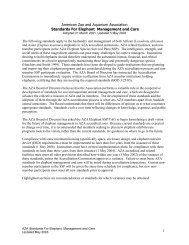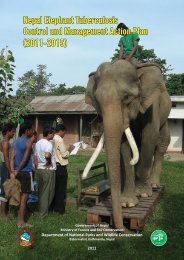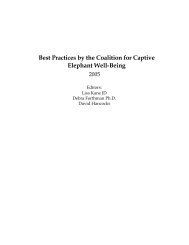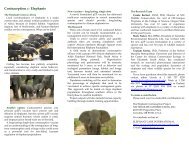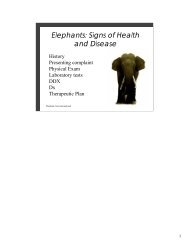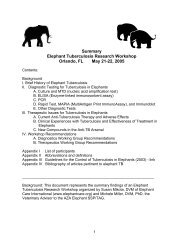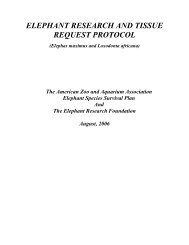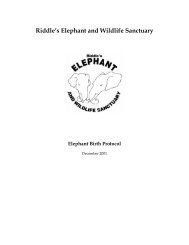Elephants Elephants - Wildpro - Twycross Zoo
Elephants Elephants - Wildpro - Twycross Zoo
Elephants Elephants - Wildpro - Twycross Zoo
- No tags were found...
You also want an ePaper? Increase the reach of your titles
YUMPU automatically turns print PDFs into web optimized ePapers that Google loves.
vocalisation when in oestrus (Poole 1999) ‘the oestrus call’. Thus females cancommunicate their reproductive state by olfactory, visual and auditory means.Both Asian and African male elephants exhibit a condition known as musth.When in musth males have elevated levels of testosterone (Cooper et al 1990),aggression and reproductive activity (Poole and Moss 1981) (Poole et al 1984)(Dickerman and Zachariah 1997) (Niemuller 1991). The discharge of fluidfrom the temporal gland increases and is continuous; the penis develops agreenish colouration and dribbles a mucous discharge; they also vocalizefrequently. It has been shown that males emit volatile compounds from thetemporal gland which may inform other bulls and cows of their condition(Rasmussen et al 1990) (Rasmussen 1997). There are many questions as to thefunction of musth (Wingate and Lasley 2001) and a suggestion that it may be arelatively recent phenomenon in the African species (Rasmussen et al 1990). InAmboseli no male under 24 years of age has been seen in musth and bouts ofmusth among individuals of the 25-35 age group are short and sporadic, whileolder males have longer bouts lasting several months (Poole 1989a). Thiswork has also shown that the number of males in musth correlates closelywith the number of oestrus females and is highest during the rainy season,when females are more likely to ovulate. Information from Sri Lanka (Kurt,pers com) and India (Desai and Johnsingh 1995) show that bulls over 20 yearsof age have longer musth periods and that bulls have individual periods ofmusth. Both Asian and African bulls settle into a regular cycle of musth withincreasing age.It has recently been demonstrated that the chemical composition of musthmales changes with age in Asian elephants (Rasmussen et al 2002); youngestmales (8-13 yrs) exhibited a honey like odour which changes to a more foulsmellingcompound as animals mature (25-35 age group). <strong>Elephants</strong> cantherefore distinguish between older and younger musth males.It has been shown that females can distinguish, by olfaction, between musthand non-musth males and also that they are more responsive during thefollicular stage of the oestrus cycle (Ganswindt et al 2005) (Schulte andRasmussen 1999). Oestrus females enter into consortship with a musth malewho guards her from copulatory attempts from lower ranking males. Femalesalso prefer older musth males and males in musth rank above non-musthmales in agonistic interactions (Poole 1989a). Thus in the Amboselipopulation, males did not complete successfully for females until they were 25or older and large musth males of over 35 were more frequently seenguarding females mid-oestrus. Males may check the reproductive state offemales by putting the trunk tip to the vulval opening and then inserting it inthe mouth, the elephant equivalent of flehmen.Copulation is rapid, the male mounts the female from the rear and mountingand copulation take on average 45 seconds (Estes 1991). Females may give alow frequency post-copulatory call (Poole 1989b).30




